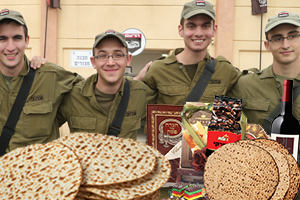For the ‘Threads’ exhibition, fashion designers created modern-day garments for 10 iconic women of the capital’s past.
By Yoni Cohen for Jerusalem Post
Eilat Leiber, the new director of the Tower of David Museum, is on a mission to show the world how influential Jerusalem as a city can be. As part of the Summer of Inspiration, Leiber is bringing a contemporary dialogue between artists and viewers to the Tower of David. The new program was inspired by Jerusalem’s long and colorful history, in particular the personalities who have had a significant influence on the city.
One such initiative is “Threads,” a contemporary fashion exhibition inspired by the women of Jerusalem. In a unique twist on fashion design, 10 leading Israeli fashion designers were paired with strong female figures from Jerusalem’s past and were asked to create a contemporary outfit inspired by the character and the legacy she left.
The exhibition aims to tell the story of a number of very influential women who shaped the history of Jerusalem.”Threads” uses fashion to delve into the world of these iconic figures by exploring what they may have worn and the legacy it represents.
“We chose historical female figures who really influenced the city,” says Leiber. “We looked for artifacts and illustrations that would give us better insight into how they would look and what they did in the city.”
Ten females who changed the face of the city were chosen, among them the Queen of Sheba, Empress Helena, Shlomzion Alexandra and Hemda Ben-Yehuda.
Leiber explains that they narrowed the list down to 10, but there were many more who would have been worthy of being included in the project.
“A lot of these women are not very well known, simply because they are women. They were left in the dark,” she explains. “We felt the need to give them a chance to be in the spotlight.”
In order to give the historical figures the respect they deserve, Leiber, along with curator, fashion photographer and journalist Tamar Karavan, chose well-established Israeli fashion designers who deal mainly with haute couture collections to design the final pieces. “We wanted designers who are known for their high standards,” Leiber says.
Even though many of the characters lived long ago, the aim was to make the design process as realistic as possible.
“We asked the designers to think about what they would have created for the women if they had entered their shops looking for an outfit,” Leiber explains. “The idea was that the designers would treat the historical women as they would a regular client and try to ensure that they would be satisfied with the final product.”
Some of the high-profile designers include Aluma, Raziella, Tamar Primak, Rachel Cohen, Karen Oberson and Hagar Alembik.
Primak, who graduated with honors from the Shenkar Design and Textile Academy and has designed for top labels in the UK and Germany, was tasked with creating an outfit for Queen Helena of Adiabene (Heleni Hamalka). The designer says she took the concept very seriously by doing extensive research on the queen.
“It was a brilliant match,” she says.
“I think it’s interesting to see my interpretation of someone who has been dead for a long time.”
When faced with the challenge of creating a dress for a woman who lived hundreds of years ago, Primak explains that in her contemporary work she gets a lot of inspiration from ancient women. “The dress I designed is timeless. It was made for a queen.”
She used a lot of gold and metal, which reflects the color of the Old City. “I always respect the women I create garments for, and this is a jewel dress for a very important woman, with a lot of emphasis on the woman’s body without exposing it too much,” she says.
The successful designer is quick to point out that while the exhibition is of a high standard, “you don’t have to be an expert to understand and appreciate it.”
Another designer who had a deep connection with the woman she designed a dress for is Hagar Alembik, who at 58 is the oldest designer to take part in the project. She was tasked with creating an outfit for Else Lasker-Schüler, a Jewish German poet and playwright famous for her Bohemian lifestyle in Berlin and lived out her latter years in Jerusalem.
“Lasker-Schüler really spoke out to me. She is someone who had a lot of influence on a number of people’s lives,” says Alembik. “I was already familiar with her story, and it really fascinated me.”
One of the main reasons Alembik got involved with the project is that “it was fun.” But on a more serious level, she notes that the exhibition is all about freedom, and that is something she connected with.
The creative outfits will be on display at the Tower of David Museum, together with a photography exhibition of the clothes being modeled in different parts of the city by well-known personalities such as actress Keren Mor, writer Zeruya Shalev, choreographer Renana Raz, actress Dana Ivgy and singer Ester Rada.
“It was important to photograph real women wearing the dresses and not models,” says Leiber. “We tried to photograph the dresses in places where the women they are designed for would have lived and worked.”
Send Passover Packages to Needy Israeli Soldiers - Bring Them Joy!
We are honored to thank the young men and women of the IDF who risk their lives every day to protect the citizens of Israel. Since October 7th, soldiers have been on the battlefield for months - many are hoping to come home for Passover.
Join us in sending Passover food packages (and personal notes) to Israeli soldiers and their families.
Many soldiers spend the Passover holiday with needy families back home. The soldiers greatly appreciate your love and concern. Bring them Passover joy!
CLICK HERE TO SEND YOUR PACKAGE AND NOTE TO ISRAELI SOLDIERS!



